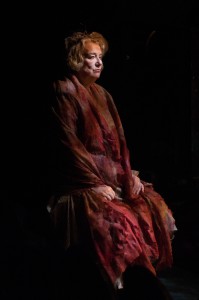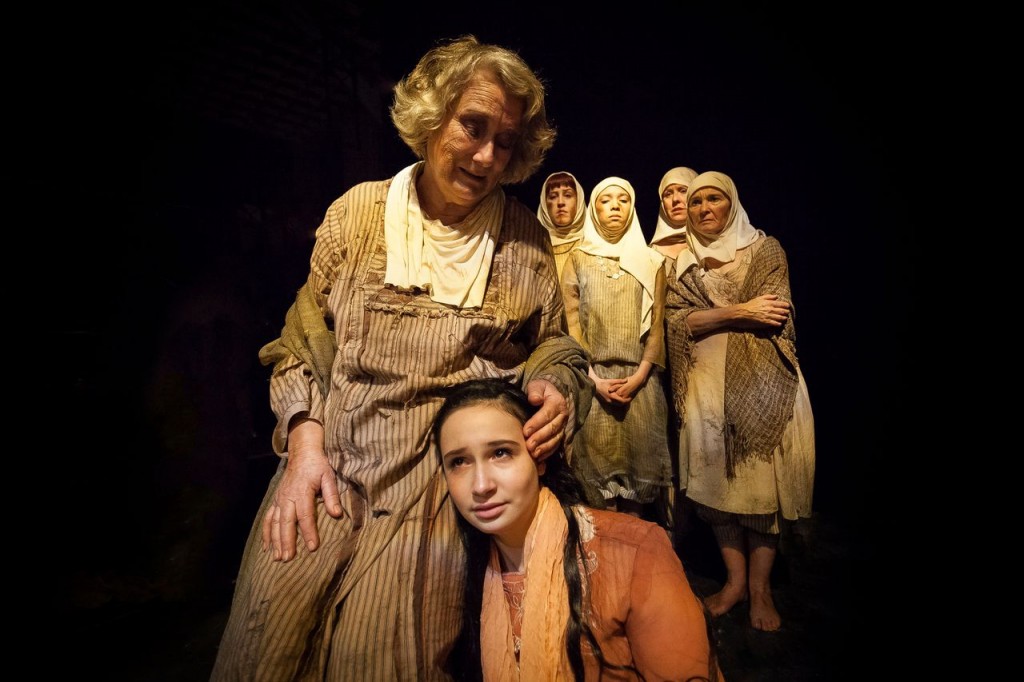
Credit: Graham Ockley
At Jericho Arts Centre until February 17
604-224-8007/unitedplayers.com
Posted on February 11, 2013
If you wonder what possible relevance Hecuba, written by Euripides in 424 BC, has for us today, consider Hecuba’s words from Scene 2: “Failing justice, there is only rage.” If that doesn’t explain protests exploding all over the world, what does? Is it too much to ask for justice? Do rich and poor alike have access to it? And if justice is denied, what recourse do victims have?
These are the questions at the heart of Hecuba, and Nicholas Kilmer lays them out crisply and clearly in his newly commissioned adaptation. Director Charles Siegel takes this script and, working with a cast that is mainly non-professional (except for Robert Ruttan, Mac Dodge and Chris Robson) plus a handful of young adults and two elementary school-aged youngsters, makes the play and its political/philosophical/psychological issues very accessible.
At the centre of the story, obviously, is Hecuba (Joan Bryans), widow of Priam, King of Troy, which has just been sacked by the Greeks under the mighty Agamemnon (Ruttan). Troy is still seen as a smoking ruin from nearby Thrace where Hecuba is a prisoner of war. Her husband is dead; most of her sons died on the battlefield; her daughter Polyxena (Matreya Scarrwener) is about to be sacrificed to honour the fallen Greek hero Achilles; Cassandra, another daughter, is the “bed-slave” of Agamemnon; and the worst is yet to come.
And it’s this ‘worst’ that sends Hecuba over the top.
This is a monumental role – the equivalent of King Lear in Shakespeare’s play. But Hecuba isn’t driven mad; she gets mad and is driven to acts of unspeakable brutality.
It speaks to the skill of Euripides, Kilmer, Siegel and this dedicated cast that we are caught inwardly applauding Hecuba’s vengeance. How can we possibly condone such violence? But what is left to her when she’s denied justice in the name of political expedience?
Bryans, a retired UBC philosophy professor and a Visiting Scholar at Oxford, has doubtless wrestled with such ethical questions in her academic career and her performance reflects it; her Hecuba draws on law and logic with which Bryans is well acquainted. Bryans’ Hecuba, in tatters and covered in blood, argues her character’s case like a lawyer: with well-founded arguments.
There must be justice. Even a female slave has a right to justice.
Bryans looms larger than life and when her Hecuba cries, “There must be justice. Even a female slave has a right to justice”, she delivers it with such passion you feel like leaping to your feet and shouting, “Right on, Hecuba.”
Dressed in a blue naval uniform, Ruttan portrays Agamemnon who waits for wind to set sail back to Mycenae and his wife Clytemnestra (who, you might recall, has a big, bad surprise waiting for him.) Ruttan’s performance is somewhat more stylistically contemporary than some others, which serves to highlight the continuing problems of world leaders – then and now – as they attempt to deal with unruly allies. Agamemnon and Thrace. Obama and Israel. Harper and China.
Chris Robson gives a spirited – sometimes too spirited – performance as Polymestor, Agamemnon’s unscrupulous ally. But I suppose, face bandaged and drenched in ‘blood’, Robson is naturally drawn into some histrionics.
What to do with the chorus? Since the actors in these Greek plays originally wore masks and high wooden clogs, they didn’t move around much. The chorus, however, was barefoot and unmasked. Director Siegel chooses to animate the chorus and provide music (Daniel Marshall) and choreography for them. It’s a pretty effect but a bit self-consciously arty. Whatever you do, the chorus is problematic.
With battle-weary, raggedy costumes by Brandi Rawluk, Jessica Oostergo’s sand circle set and a cast of thirteen, Hecuba is a huge undertaking. United Players, once again, shows boldness in its programming and shrewdness in its reminder that the really big questions are still rattling around twenty-five hundred years after Greece’s magnificent Classical period.

Credit: Lee Buckley

